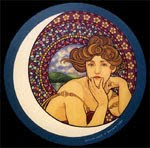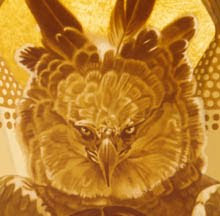How did this art project come about?
Bruce Diamond and I met playing around town together in various bands. Bruce is not only a versatile musician, but he also makes a living as an instrument dealer for his business
Diamond Strings.
He discovered I was an artist. I mentioned to him that I could paint artwork on guitars. He said he had the perfect project for me and asked if I would be interested in painting a replica of Eric Clapton's famous
Cream Fool SG, circa 1967.
 |
| Beth Brown and Bruce Diamond |
How could I refuse such an interesting and challenging commission? It was right up my alley artistically and musically. So that's how it all started, folks!
______________________________________________
Now that the painted psychedelic artwork on the guitar is finished, I'll feel better if I put a clearcoat on it before it leaves my studio. Don't want any accidental scratches on all the hard work I've done!!! Bruce will apply more coats to further protect it when he gets the guitar home.
I'll start with the pickguard.
I'm brushing it on rather than spraying it. I do not like to breathe fine spray vapor, thanks very much.
I'm using a product I'm familiar with, Zar fast-drying polyurethane
Clear Antique Flat. I've used it before on many other painting projects. It has a slight yellow tint to it. This will help to make the guitar appear a bit yellow with age.
I've carefully taped blue painter's tape around the headstock and under the guitar body to prevent the polyurethane from dripping over the edges of the painted artwork. The tape can be peeled off after the poly dries for a nice clean edge.
The flat polyurethane may look glossy when it goes on, but when it dries it will not have much of a sheen. Bruce will apply a heavy duty gloss finish later on.
Okay, the guitar has dried overnight.
I contacted Bruce to come and pick up his guitar. Here he is pictured with the finished product!
 |
| Bruce Diamond with his very own Fool SG |
He will take it home and spray numerous coats of gloss polyurethane on it,
then attach the hardware, strings, etc. I hope he will bring it back so I can get more photos of the completed piece.
I am so glad to have played a starring role in Bruce Diamond's long awaited Fool Guitar dream-come-true!!! It's been an arduous journey, but a great learning experience and an artistic notch in my belt.



















































+by+Beth++blog+photo.jpg)